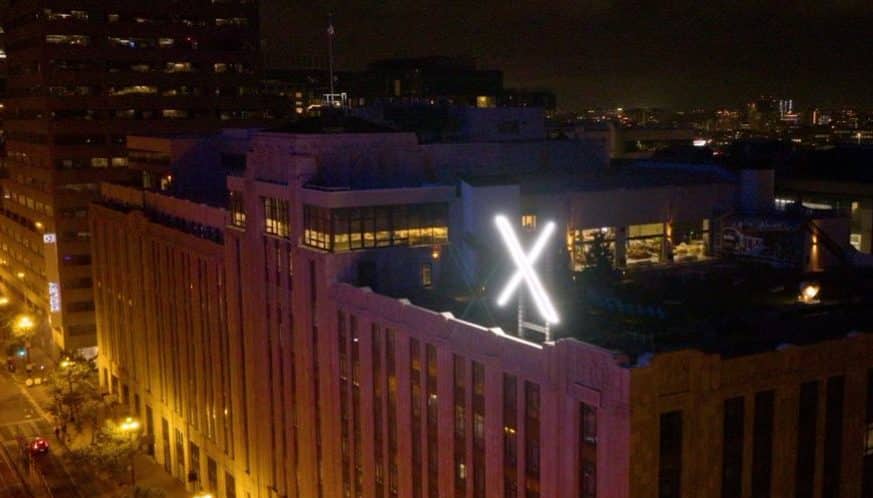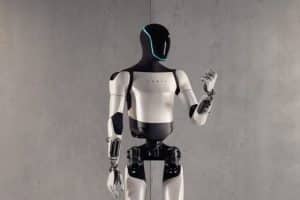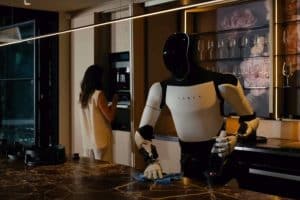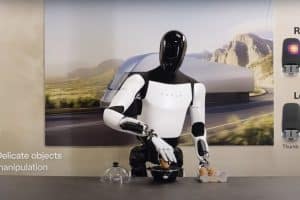- 🤖 Elon Musk has teased the next iteration of Tesla’s humanoid robot, Optimus 2.0, on X.
- 📅 The new Optimus design is expected to be complete later this year.
- 🔄 Over the past year, Tesla has made three major design revisions and four updates to the robot’s hands.
- 🏭 At least two Optimus bots are already navigating autonomously in Tesla’s offices and labs, performing tasks.
- 📈 Tesla aims to start selling the Optimus robot externally by the end of 2025.
- 🛠️ The robots are expected to perform useful tasks in Tesla’s factory before the end of this year.
- 📦 Tesla plans to rent out Optimus robots ahead of sales.
As the world keeps an eager eye on the advancements in artificial intelligence and robotics, Elon Musk is once again leading the charge with exciting news. Recently, Musk teased the next iteration of Tesla’s humanoid robot, Optimus 2.0, on the social media platform X (formerly known as Twitter). Here, we explore the intriguing details about Tesla’s progress with Optimus, delve into the anticipated features, and discuss the potential implications of these advancements.
Elon Musk has never been one to shy away from daring innovations and ambitious projects. From electric vehicles to space travel, Musk’s ventures consistently push the boundaries of technology. The latest buzz surrounds Tesla’s humanoid robot, Optimus 2.0, which Musk recently teased on X. This announcement has generated significant excitement and speculation about the capabilities and future applications of this advanced robot. Let’s dive into what we know so far and what the future may hold for Tesla’s robotic marvel.
The Teasing of Optimus 2.0
In a recent post on X, Musk revealed that the new design for Optimus 2.0 is expected to be finalized later this year. He described it as “something special,” hinting at significant improvements and potential new features. The unveiling of Optimus 2.0 later this year will likely showcase the culmination of extensive research, rigorous testing, and cutting-edge innovation.
Design Revisions and Updates
Over the past year, Tesla has been busy refining the design of Optimus. Here are the key updates:
- Three Major Design Revisions: The initial design has undergone three significant revisions to enhance functionality, efficiency, and aesthetics.
- Four Hand Updates: Recognizing the importance of dexterity, Tesla has revised the robot’s hands four times over the past two years to improve their performance and adaptability.
These changes suggest that Tesla is committed to ensuring Optimus can perform complex tasks with a high degree of precision and effectiveness.
Current Capabilities
Tesla has not been shy about putting Optimus to work, even in its developmental stages. The company has deployed at least two Optimus bots within its offices and labs, where they navigate and perform tasks autonomously. This practical application serves as a testing ground for the robots, allowing Tesla to fine-tune their capabilities in real-world scenarios.
Future Plans for Optimus 2.0
Factory Tasks
Before the end of this year, Tesla plans for the Optimus robots to undertake useful tasks within its factories. This move signifies a step towards integrating robotics more deeply into manufacturing processes, potentially increasing efficiency and reducing human workload.
External Sales by 2025
Musk has projected that Optimus could be available for external sales by the end of 2025. This timeline sets ambitious goals for both development and production but also hints at Tesla’s confidence in the robot’s market readiness.
Rental Opportunities
In a strategic move to increase accessibility and generate revenue, Tesla also plans to rent out the Optimus robots ahead of initiating sales. This rental strategy could provide businesses with the opportunity to leverage advanced robotics without the high upfront costs.
Potential Impact and Implications
The introduction of Optimus 2.0 holds significant promise for various sectors:
- Manufacturing: Robots like Optimus could revolutionize factory operations by taking on repetitive, dangerous, or labor-intensive tasks, thereby improving safety and productivity.
- Healthcare: Humanoid robots could assist in elderly care, rehabilitation, and even complex surgeries, where precision and consistency are crucial.
- Service Industry: From performing customer service roles to managing logistics, humanoid robots could enhance efficiency and customer satisfaction.
Conclusion
Elon Musk’s recent tease of Tesla’s Optimus 2.0 has added a new layer of excitement to the future of robotics. With thorough design revisions, ongoing real-world testing, and ambitious plans for factory integration and market availability, Optimus 2.0 is set to make a significant impact in various industries. As we await its final design later this year, the world watches with bated breath to see how Tesla’s humanoid robot will redefine the landscape of automation and artificial intelligence.





